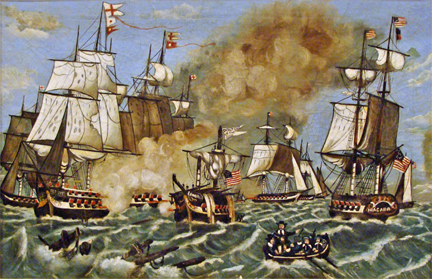Five naval battles that
changed American History

To be considered a superpower, a state must be able to
project its naval power across the seas and oceans.
U.S. has exploited
its excellent geostrategic position
between the Atlantic and Pacific
, gradually building the rule over the
seas . The control of trade routes and supply bases are the main condition for
a state to be considered a naval power. When you have command of the sea, you
can severely limit the strategic options of your opponents. The Royal Navy is
the perfect model for a state that managed to build a colonial empire by using
the professionalism of its naval forces, which have protected the supply routes
for British merchant ships.
As a former British colony, U.S has shown that it learned
well the lesson regarding command of the seas .
Professor Craig L. Symonds of U.S. Naval Academy identified in his book, “ Decision
at Sea : Five Naval Battles that Shaped American History” ,the
five crucial moments in American History in which naval forces played
a key role.
1.Battle of Lake Earie( 10 september 1813)
Battle of Lake Earie is part of the War of 1812 ,also referred to as the "Second
War of Independence". In this naval confrontation that took place in the
area of Great Lakes , 9 American
warships captured 6 British
warships.The victory in this battles, allowed the Americans to recover
Detroit and win the next Battle of Moraviantown
(5 October 1813) against the Indian confederation of Tecumseh.

2. Battle of Hampton Roads (8-9 March 1862)
Was one of the most important battles of the American Civil
War (1861-1865) ,that marked in the same
time a historic moment in the
design and construction of warships. Is the battle that highlights the first
iron clad , CSS Virginia(Ex- USS Merrimac) , belonging to Confederacy. CSS
Virginia sailed in the estuary of Elizabeth River(Virginia) to break the Union
Navy blockade composed of wooden-hulled
ships . At the end of the battle, CSS
Virginia detached from all other ships and marked a new chapter in the history
of naval warfare, and also has inaugurated a new class of warships known as
monitors. It is interesting to note that the CSS Virginia was protected by iron
only up to waterline. In other words, it was vulnerable under waterline.

3. Battle of Manila Bay ( 1 May 1898)
Battle of Manila Bay is a part of Spanish–American War of 1898 ,that marked the collapse of
Spanish colonial empire and
asserting the status of great power of United States . Manila Bay naval
confrontation was the most decisive battle in the history of naval history because
it resulted in the end of the Spanish colonial period in the history of the
Philippines.

4. Battle of
Midway (4 June 1942)
Battle of Midway was one of the most important battles of World
War II, that took place In the Pacific theater of operations . U.S. naval
forces have achieved a decisive victory, inflicting insurmountable damage on
the Japanese Imperial Fleet
The great importance of the Battle of Midway is underlined
by military historian John Kaegan ,,which called it “the most stunning and decisive blow in the
history of naval warfare”.
American code breakers were able to determine the
date and location of the attack, enabling the forewarned U.S. Navy to set up an
ambush of its own. Four Japanese aircraft carriers and a heavy cruiser were
sunk in exchange for one American aircraft carrier and a destroyer. Japanese
plan to draw in trap US aircraft carriers was a disaster. It was Japan’s worst defeat
in 350 years of history
Image: Japanese
Mogami class cruiser wreck

5. Operation Praying Mantis (Persian Gulf, 18 April 1988)
Operation Praying Mantis was a U.S. Navy military action in
retaliation for the Iranian mining of the Persian Gulf , during Iran-Iraq War(1980-1988).
The incident with the frigate Samuel B Roberts damaged by an Iranian mine, is
the triggering factor of US Navy strike.
This battle was the largest of the U.S. surface engagements since World
War II. For the first time in US Navy history, US has used
anti-ship missiles.
Image with Iranian
frigate IS Sahand (F-74)wreck in
flames

Sources:
Craig L. Symonds , Decision at Sea : Five Naval Battles that
Shaped American History , Ed. Oxford University Press,New York , 2005.
Niciun comentariu:
Trimiteți un comentariu